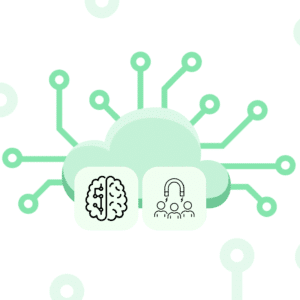Machine learning, the backbone of self-driving cars and voice assistants, may seem complex for novices. Yet, even if you’re new to coding, you can start this thrilling journey. This guide offers a beginner-friendly path to begin your machine learning journey. You’ll grasp essential concepts, algorithms, and practical uses to explore the vast potential of this evolving field.
Key Takeaways
- Explore the fundamental principles of machine learning, including supervised and unsupervised learning techniques.
- Understand the diverse range of machine learning algorithms and their real-world applications.
- Discover the benefits of learning machine learning, such as increased efficiency, personalized experiences, and data-driven decision-making.
- Identify the essential prerequisites for machine learning, including programming basics and mathematical foundations.
- Dive into the machine learning fundamentals, including data preprocessing, feature engineering, and model evaluation metrics.
Introduction to Machine Learning
In our digital era, machine learning has emerged as a pivotal technology. It powers many of the innovative tools we use daily. From Netflix’s personalized recommendations to our smartphones’ predictive texts, machine learning underpins these intelligent systems.
What is Machine Learning?
Machine learning is a subset of artificial intelligence. It deals with developing algorithms that can learn from data and make predictions or decisions autonomously. These models analyze data patterns to uncover insights, enabling more efficient, data-driven solutions to complex problems.
Understanding AWS Machine Learning
AWS machine learning is a subset of artificial intelligence focused on developing algorithms that learn from data to autonomously make predictions or decisions. These models analyze patterns in data, enabling efficient, data-driven solutions to complex problems.
Applications of Machine Learning
Machine learning has numerous applications across various sectors, including healthcare, finance, transportation, and e-commerce. Some notable examples include:
- Spam filtering to automatically detect and block unwanted messages
- Predictive maintenance to anticipate equipment failures and schedule proactive repairs
- Sentiment analysis to understand customer opinions and preferences
- Autonomous vehicles to navigate the roads safely and efficiently
Benefits of Learning Machine Learning
As the need for data-driven solutions grows, grasping machine learning’s basics can open up significant opportunities. By becoming proficient in this technology, you can:
- Develop innovative applications that address real-world challenges
- Derive valuable insights from data to enhance decision-making
- Automate repetitive tasks and streamline business operations
- Stay competitive in a rapidly evolving job market
Whether you’re a budding data scientist, a software engineer, or simply intrigued by technology’s latest advancements, learning machine learning can broaden your horizons. It empowers you to navigate the future with confidence and stay at the forefront of technological progress.
Prerequisites for Machine Learning
Embarking on the machine learning journey requires a strong foundation in programming and mathematics. While not mandatory, having a basic grasp of a language like Python can significantly benefit you. Python stands out due to its straightforward syntax and robust libraries such as NumPy, TensorFlow, and scikit-learn, making it a favored choice for learners.
Mathematical concepts are equally vital for machine learning. Understanding linear algebra, calculus, and statistics and probability deepens your grasp of algorithms and models. These subjects provide the tools for data analysis, pattern recognition, and predictive capabilities.
Programming Basics
Having proficiency in a language like Python or R is crucial for implementing machine learning algorithms and handling data. Python is particularly favored for its extensive library support and simplicity. Get to know Python’s syntax, data structures, and libraries such as NumPy, pandas, and scikit-learn. Practical experience through online courses, tutorials, and projects will sharpen your programming skills.
Mathematics Fundamentals
Grasping the mathematical underpinnings of machine learning is essential. Focus on the following areas:
- Linear Algebra: Essential concepts include vectors, matrices, and transformations, crucial for machine learning algorithms.
- Calculus: Understanding differentiation, integration, and partial derivatives is vital for optimizing models and analyzing complex functions.
- Statistics and Probability: Knowledge of mean, median, and probability distributions aids in data analysis and prediction.
Building a strong foundation in these mathematical disciplines prepares you to delve deeper into machine learning and solve complex problems with confidence.
| Concept | Relevance in Machine Learning |
|---|---|
| Descriptive Statistics | Transforms raw data into a format suitable for machine learning models. |
| Inferential Statistics | Extracts insights from a sample, rather than the entire dataset. |
| Linear Algebra | Focuses on vectors, matrices, and transformations, key to machine learning algorithms. |
| Calculus | Essential for complex models with multiple features. |
| Probability | Crucial for predicting likelihood in machine learning algorithms. |
Mastering programming basics and key mathematical concepts sets you up for success in machine learning. This prepares you for an exciting journey of discovery and innovation.
Machine Learning Fundamentals
In the realm of machine learning, three primary strategies drive the algorithms: supervised learning, unsupervised learning, and reinforcement learning. Each method offers distinct advantages, fitting specific problems and datasets.
Supervised Learning: This method trains algorithms on labeled datasets, where each piece of data has a target variable. The algorithm learns to link data features with labels, enabling it to predict or classify new data. Tasks like regression and classification fall under supervised learning.
Unsupervised Learning: Unlike supervised learning, unsupervised learning tackles unlabeled data. The algorithm’s goal is to find patterns or structures in the data without knowing the target variables. Techniques like K-means and DBSCAN are key in unsupervised learning.
Reinforcement Learning: This strategy involves an agent interacting with an environment, taking actions, and receiving rewards or penalties. The agent aims to make decisions that maximize rewards, solving complex problems effectively.
Machine learning algorithms find applications in various fields, from predicting stock trends to identifying fraud, and from automating customer service to powering self-driving cars. As data grows, so does the role of machine learning in uncovering insights and driving innovation.
| Machine Learning Type | Description | Examples |
|---|---|---|
| Supervised Learning | Algorithms are trained on labeled data to predict target variables | Linear Regression, Logistic Regression, Decision Trees, Support Vector Machines |
| Unsupervised Learning | Algorithms find patterns and structures in unlabeled data | K-means Clustering, Hierarchical Clustering, Gaussian Mixture Models |
| Reinforcement Learning | Algorithms learn by interacting with an environment and maximizing rewards | Q-Learning, Policy Gradients, Deep Q-Networks |
Exploring machine learning further requires grasping these fundamental concepts and the algorithms behind them. Mastering supervised, unsupervised, and reinforcement learning can unlock the potential of data-driven decisions, transforming industries worldwide.
Machine Learning Algorithms
Regression Algorithms
In the realm of machine learning, grasping the variety of algorithms is crucial. Regression algorithms, including linear regression, polynomial regression, and decision tree regression, excel at predicting continuous outcomes. They establish the link between input variables and the target variable, enabling precise forecasts.
Linear regression is a fundamental method that maps a linear relationship between a dependent variable and independent variables. Random forest regression and gradient boosting regression stand out for their strong performance and ability to tackle complex, non-linear patterns.
Classification Algorithms
Classification algorithms, in contrast, aim to forecast discrete labels or categories. Logistic regression, decision tree classification, and support vector machines are key algorithms for this purpose. They are adept at tasks like predicting customer churn, identifying spam emails, or categorizing images.
Logistic regression is a vital tool for binary classification, employing a logistic function to estimate the likelihood of a binary outcome. Random forest classification combines multiple decision trees to enhance prediction accuracy and stability.
Knowing the strengths and applications of regression and classification algorithms is vital for advancing in machine learning. By becoming proficient in these foundational techniques, you’ll be well-prepared to address a broad spectrum of predictive modeling and decision-making tasks.
Machine Learning for Beginners
If you’re a beginner eager to explore machine learning, you’ve found the right spot. This field is crucial in many sectors, from e-commerce to healthcare, and beyond. To begin, focus on practical projects that offer hands-on experience and a solid foundation.
Start with small projects using libraries like scikit-learn in Python. These can include simple linear regression or complex classification tasks. This lets you apply what you’ve learned. As you advance, try Kaggle competitions for real-world datasets and challenges to sharpen your skills.
For beginners, GitHub repositories are also a treasure trove. They’re filled with code examples, tutorials, and project ideas. By examining and experimenting with this code, you’ll deepen your grasp of machine learning concepts.
Success in machine learning requires consistent practice and a willingness to experiment. Don’t hesitate to explore new approaches, even if they lead to mistakes. With persistence and a growth mindset, you’ll quickly become proficient.
Here are some tips to keep in mind as you start your machine learning journey:
- Begin with small projects to build confidence and skills.
- Explore Kaggle competitions to tackle real-world datasets and challenges.
- Delve into GitHub repositories for inspiring projects and insights from experts.
- Adopt a growth mindset and view setbacks as opportunities for learning.
Machine learning is vast and constantly evolving. Be patient and enjoy the learning process. With persistence and the right approach, you’ll soon become adept at machine learning.
Advanced Topics and Specializations
As you delve deeper into the world of machine learning, you’ll find yourself exploring more advanced topics and specializations. These areas allow you to tailor your skills and expertise to specific domains or applications. This opens up a wealth of possibilities for your career growth.
Deep Learning Fundamentals
Deep learning is a rapidly evolving field within machine learning. It focuses on developing artificial neural networks inspired by the human brain’s structure and function. These algorithms excel at learning from complex, unstructured data. They are particularly powerful for tasks like computer vision, natural language processing, and speech recognition.
Specializations in Machine Learning
Beyond the core principles of machine learning, there are numerous specializations. These allow you to hone your skills in specific areas. Some popular specializations include:
- Computer Vision: Mastering techniques for image and video analysis, object detection, and image classification.
- Natural Language Processing (NLP): Developing models and algorithms for understanding, interpreting, and generating human language.
- Reinforcement Learning: Exploring the principles of learning through trial and error, with applications in robotics, game-playing, and decision-making systems.
Staying up-to-date with the latest research and advancements in machine learning is crucial. Continuous learning through online courses, industry conferences, and active participation in the machine learning community can help you expand your knowledge and expertise. This field is rapidly evolving.
| Specialization | Ratings | Learners Enrolled | Course Duration |
|---|---|---|---|
| Machine Learning Specialization | 4.9/5 | 4.8 million | 2.5 months (5 hours/week) |
| Deep Learning Specialization | 4.9/5 | 2.3 million | 3 months (5 hours/week) |
| Natural Language Processing Specialization | 4.8/5 | 1.2 million | 3 months (4 hours/week) |
| Reinforcement Learning Specialization | 4.7/5 | 850,000 | 3 months (4 hours/week) |
By exploring these advanced topics and specializations, you can unlock new opportunities. You can also deepen your expertise in machine learning. This positions you for greater success in your career.
Conclusion
Embarking on the journey of learning machine learning opens up a realm of possibilities. Through diligent practice and active community engagement, we can master this field. This mastery enables us to tackle real-world challenges, automate tasks, and make decisions backed by data. Whether aiming for a machine learning career or just to boost skills, the future is bright.
It’s crucial to keep pace with the latest in machine learning, from training to certifications. Immersing ourselves in the community, attending events, and finding mentors can enhance our knowledge and speed up our progress. By tackling the challenges and relishing the excitement, we pave the way for machine learning to transform industries and daily life.
The landscape of machine learning is ever-changing, with a growing need for experts. Starting our machine learning journey now prepares us for success in a data-driven era. Let’s approach this path with eagerness, a thirst for knowledge, and a dedication to ongoing learning. Together, we can tap into the vast potential that machine learning offers.
For businesses aiming to streamline their cloud migration process and maximize the benefits of cloud computing, DinoCloud is here to help. Our team of cloud experts can guide you through every step of your migration journey, ensuring a smooth transition and optimal results. Discover more about how DinoCloud can support your cloud migration strategy here!
FAQ
What is machine learning?
Machine learning is a branch of computer science within artificial intelligence. It involves training machines to recognize patterns in data. This enables them to make predictions based on those patterns.
What are the benefits of learning machine learning?
Learning machine learning unlocks a world of possibilities. It helps solve real-world problems, automates tasks, and improves decision-making through data analysis.
What skills do I need to start learning machine learning?
To begin with machine learning, focus on developing a strong programming skill set, especially in Python. Additionally, knowledge in mathematics, including linear algebra, calculus, and statistics, is crucial.
What are the main types of machine learning strategies?
The primary strategies in machine learning are supervised, unsupervised, and reinforcement learning. Each strategy has its unique approach to data analysis and problem-solving.
What are some common machine learning algorithms?
Common algorithms include regression for continuous value prediction and classification for categorizing data. Specific types are linear regression, decision tree regression, logistic regression, and support vector machines.





